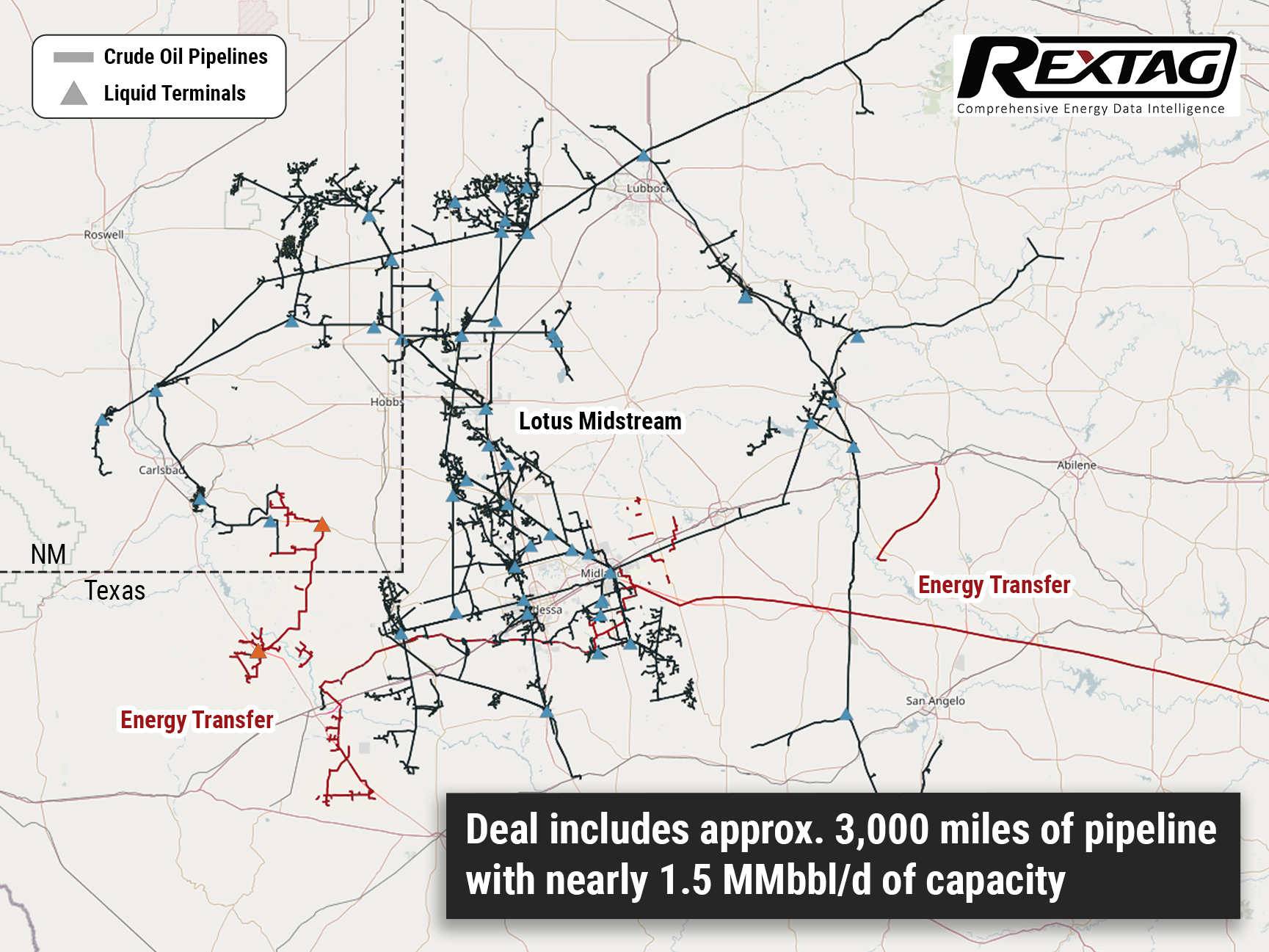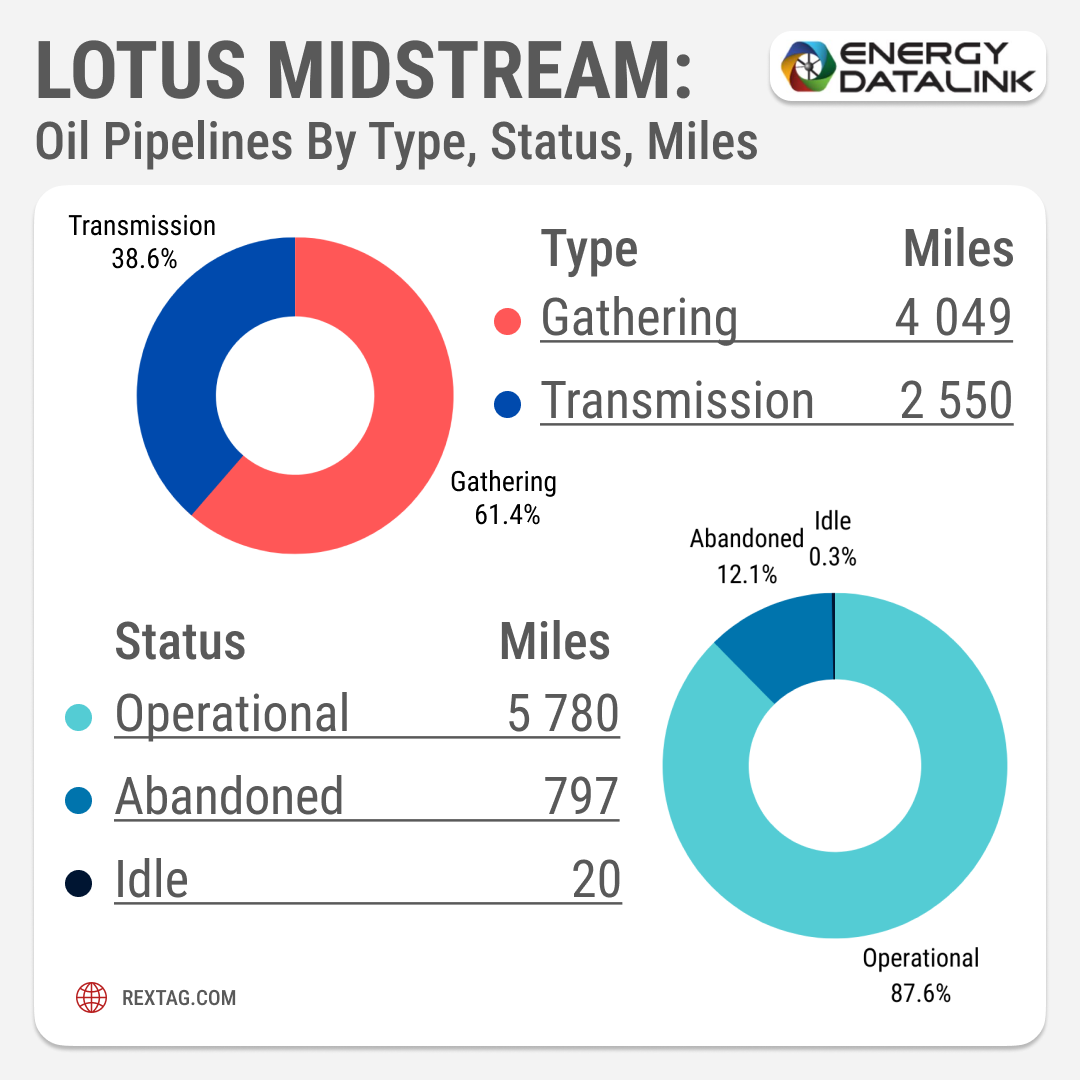Comprehensive Energy Data Intelligence
Information About Energy Companies, Their Assets, Market Deals, Industry Documents and More...
Massive Energy Deal Alert: Energy Transfer to Acquire Lotus Midstream in Permian Basin for $1.45 Billion!
04/13/2023
Energy Transfer's recent acquisition of Lotus Midstream's infrastructure for $1.45 billion is a remarkable feat that is bound to shake up the energy industry.
This strategic move grants Energy Transfer access to the highly prized Centurion Pipeline, as well as an additional 3,000 miles of crude gathering and transportation pipelines. These pipelines span across the vast Permian Basin of West Texas, stretching all the way from New Mexico and culminating at the bustling energy hub of Cushing, Oklahoma.
In a major move that has set the energy industry abuzz, Energy Transfer LP has announced its acquisition of Lotus Midstream LLC for a staggering $1.45 billion in cash-and-stock. This game-changing deal includes a vast network of pipelines, gathering, and storage facilities spanning the Permian Basin, and opens up new avenues for a connecting crude oil pipeline project from Midland to Cushing, Oklahoma.
The acquisition, from an affiliate of EnCap Flatrock Midstream (EFM), is just the latest in a series of midstream deals worth billions of dollars that have dominated the industry since late last year. From smaller bolt-on deals to multi-billion-dollar transactions like Enterprise Products Partners' acquisition of Navitas and Targa's acquisition of Lucid Energy, the sector is experiencing a flurry of activity that is showing no signs of slowing down.
According to Stacey Morris, head of energy research for VettaFi, "Energy Transfer's acquisition of Lotus is another example of a sizable acquisition of Permian assets, though this deal is different in that the assets are focused on crude gathering and transportation instead of natural gas."
Why the Permian Basin is so significant for O&G players?
The Permian Basin continues to be a hotbed of deal-making activity as midstream companies seek to bolster their positions in the most prolific producing region in the United States. With fierce competition in the region, expanding footprints and establishing enhanced connectivity to different markets is crucial for midstream companies looking to improve their offerings and transportation solutions for customers.
By acquiring new infrastructure and expanding their networks, midstream companies can provide more efficient and cost-effective transportation solutions for producers, leading to increased competitiveness and profitability for all parties involved. As such, the Permian Basin remains a highly attractive area for deal-making, with companies seeking to gain a competitive edge in this dynamic and rapidly evolving market.
In total, Energy Transfer will pay $900 million in cash and approximately 44.5 million newly issued Energy Transfer common units, solidifying its position as a leading player in the energy sector and paving the way for a bold new chapter in its history.
Sneak peek at the details
- The deal includes approximately 3,000 active miles of pipeline with nearly 1.5 MMbbl/d of capacity, connecting major production areas of the Permian Basin, including Cushing, Midland, Colorado City, Wink, and Crane. The system is anchored by large-cap producer customers with firm, long-term contracts and significant acreage dedications.
- As part of the acquisition, Energy Transfer also gains a 5% equity interest in the Wink to Webster Pipeline, a 650-mile pipeline system transporting over 1 MMbbl/d of crude oil and condensate from the Permian Basin to the Gulf Coast.
- Energy Transfer plans to begin construction on a 30-mile pipeline project, originating barrels from its Midland terminals for ultimate delivery to Cushing.
- The project is expected to be completed in Q1 2024, offering improved connectivity and efficiency for Energy Transfer and its customers.
Energy Transfer's latest acquisition deal is set to close in Q2, bringing Lotus Midstream's Centurion Pipeline Company under its umbrella. The integrated crude midstream platform, located in the Permian, offers a comprehensive range of services, including wellhead gathering, intra-basin transportation, terminalling, and long-haul transportation services.

If you are looking for more information about energy companies, their assets, and energy deals, please, contact our sales office mapping@hartenergy.com, Tel. 619-349-4970 or SCHEDULE A DEMO to learn how Rextag can help you leverage energy data for your business.
US Midstream Research 2022 Overview: TOP Providers, Their Assets and Stories
![$data['article']['post_image_alt']](https://images2.rextag.com/public/blog/R 161_ Blog - US Midstream Research Overview TOP Providers, Their Assets and Stories.png)
The midstream sector plays a vital role in the oil and gas supply chain, serving as a crucial link. As the energy transition continues, this industry, like the broader sector, encounters various risks. Yet, existing analyses have predominantly concentrated on the risks faced by the upstream and downstream sectors, leaving the fate of the midstream relatively unexplored. In a nutshell, midstream operators differentiate themselves by offering services instead of products, resulting in potentially distinct revenue models compared to extraction and refining businesses. However, they are not immune to the long-term risks associated with the energy transition away from oil and gas. Over time, companies involved in transporting and storing hydrocarbons face the possibility of encountering a combination of reduced volumes, heightened costs, and declining prices.
Breaking Barriers FireBird II, Empowered by Quantum Technology, Surpasses $500MM Funding Milestone for Permian Ventures
![$data['article']['post_image_alt']](https://images2.rextag.com/public/blog/147Blog_FireBird Energy Permian Basin assets.png)
Following the success of FireBird Energy's $1.75 billion sale to Diamondback last year, the emergence of FireBird II signals a new chapter in the Permian Basin. Get ready for some exciting news from the energy industry. FireBird Energy II, the new player in the Permian Basin, has just secured $500 million in equity funding to fuel their acquisitions. With backing from the esteemed private equity firm Quantum Energy Partners, FireBird Energy II is poised to make waves in the industry.
![$data['article']['post_image_alt']](https://images2.rextag.com/public/blog/328_Blog_Why Are Oil Giants Backing Away from Green Energy Exxon Mobil, BP, Shell and more .jpg)
As world leaders gather at the COP29 climate summit, a surprising trend is emerging: some of the biggest oil companies are scaling back their renewable energy efforts. Why? The answer is simple—profits. Fossil fuels deliver higher returns than renewables, reshaping priorities across the energy industry.
![$data['article']['post_image_alt']](https://images2.rextag.com/public/blog/327_Blog_Oil Market Outlook A Year of Growth but Slower Than Before.jpg)
The global oil market is full of potential but also fraught with challenges. Demand and production are climbing to impressive levels, yet prices remain surprisingly low. What’s driving these mixed signals, and what role does the U.S. play?
![$data['article']['post_image_alt']](https://images2.rextag.com/public/blog/326_Blog_USA Estimated Annual Rail CO2 Emissions 2035.jpg)
Shell overturned a landmark court order demanding it cut emissions by nearly half. Is this a victory for Big Oil or just a delay in the climate accountability movement?